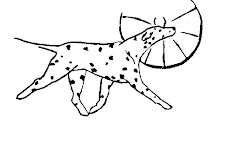
One of the first things you do when you acquire a new pet is to put a collar with identification tags on him. This is the responsible thing to do, but you should be aware that collars can also present unexpected, even fatal, dangers.
At our house, all dogs are collar-free. They play “naked” in our home and fenced yard. The only times they wear their collars are for walks and trips in the car, where we are with them at all times. Of course, if we were going to play at a dog park, this might not be the best option, as they could get tangled with their buddies.
Dogs love to wrestle and play. Mimicking the dominant posturing of their wild wolf cousins, they jump on each other and bite each other’s legs and necks. During this kind of play, it’s very easy for one to get a tooth or lower jaw caught beneath the other’s collar. And it happens fast. Wrestling isn’t the only way a collar can become a killer. Dogs can get their collars looped around short fences, decorative rod iron railings, branches and more. They can also get their tags caught in small places, such as air vents and radiators. In fear, they struggle to get free and you can guess the result.
Another way to keep your furry friend collared while lessening the danger is the KeepSafe™ Break-Away Collar. This collar is specially designed to break open under pressure, but it can still be used to walk your dog safely on a leash. On either side of the break-away mechanism is a metal ring. Simply thread the leash clip through each ring and the collar stays on during your walk. You can find embroidered collars at www.dogidcollar.com
There are those the feel that buckle collars were stronger when walking their dogs and other who just like convenience of the quick release collars. While wearing quick release collars it is much easier to free them from a dangerous situation. If they are wearing buckle collars, it would be much more difficult to release the dogs."
Another danger is present if your dog is alone, but is in a crate or on a deck. The tags on the dog's collar can be dropped between the slats of the deck and become caught. The dog, desperate to free himself, can spun and spun until he chokes himself to death. Many dogs have died when, while in their crate, they have caught their collar on the crate and been hung.
Most dog owners are aware of the dangers presented by training or "choke" collars which can be made of chain or nylon. These collars can easily become caught on a fence or other obstacle, resulting in a dog that is marooned or strangled. NEVER leave a training collar on an unsupervised dog.
The lesson in all this: Use a training or "choke" collar only for walking your dog on a leash and leave that collar permanently attached to the leash. For identification purposes, use quick release collars. If you have more than one dog and the dogs are in the habit of wrestling with each other, do not leave them unattended wearing collars. (Naturally, dogs should never be left outdoors when their owners are not at home and they should be secure in the house without collars.) Keep the collar handy by the door which the dog uses so you can put it on him before he goes out.


No comments:
Post a Comment